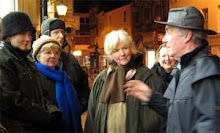
Megaliths at Avebury
The word ‘sarsen’ may be derived from old English, 'sarstan' meaning ‘troublesome stone’. Sarsens were certainly regarded troublesome by the Saxons who believed them possessed by malevolent spirits, so much so they built what is now (greatly modified by the Normans) St. James church just outside the stone circle in the hope that divine intervention would keep any evil at bay. 14th century Christians went one step further and toppled these giants into deep pits then buried them in the hope that so doing would eradicate paganism.
The alleged 'magical energy' purported to emanate from within the sarsens at Avebury and Stonehenge is debatable, but there are many dowsers and some who choose to follow earth religions who firmly believe such energy exists. It is unlikely however, that the late neolithic ‘stone builders’ at Avebury would have regarded the sarsens in quite the same way. It is more likely they would have seen them as fortuitously convenient building material for their monument. Foremost in their minds would surely have been the huge logistical challenge and manpower required to transport, erect and aligning the stones in preparation for the important ceremonies and seasonal celebrations to follow its construction.
There is certainly nothing magical, geologically speaking that is, as to how these giant boulders came about. Sarsen stone is an immensely hard silicified quartzite sandstone formed around 23 million years ago. It was during the last glacial ice age, which ended around 12,500 years ago, that water erosion and shifting, freezing and thawing glacial ice flows exposed, eroded and broke up this crust of sarsens into millions of lose boulders which were left scattered across the Wessex landscape. Many can still be seen lying at Piggledene and Lockeridge just off the A4 between Beckhampton and Marlborough.
For the stone builders, sarsen stone would have been notoriously difficult to fashion due to its resistance to abrasion. This may account for the sarsens at Avebury not having been ‘worked’ but instead selected for their shape. Tall thin stones are thought by some to be symbolic of the male gender whilst short diamond shaped stones symbolic of the female gender. This arrangement can be seen at the West Kennet Avenue where male and female stones stand opposite one another along its course, further endorsement that the monument may have been built to celebrate fertility and growth.
It was the abundance of sarsens in the Wessex landscape that proved decisive at a time when the stone builders were considering where to construct the monuments which now stand at Avebury and Stonehenge.
There is an old local saying from the turn of the 18th century which claimed it possible to ‘walk from Avebury to Lockeridge without ever touching the ground as there were so many sarsen stones to step on‘.






2 comments:
This is a wonderful post Willow...as is this terrific blog. My partner is one of the admins of Hauntings/Haunted Places on Facebook. I am going to tell him about your blog. Thanks so much, Will
Thanks for your kind comments 'Willy.' So glad you're enjoying the blog.
Post a Comment